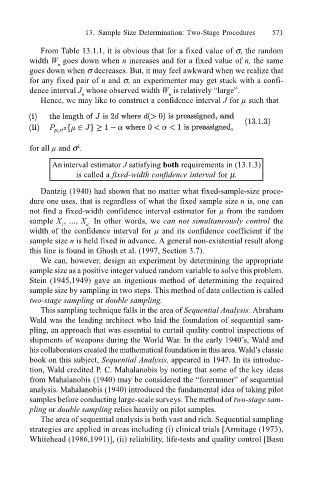Page 594 - Probability and Statistical Inference
P. 594
13. Sample Size Determination: Two-Stage Procedures 571
From Table 13.1.1, it is obvious that for a fixed value of σ, the random
width W goes down when n increases and for a fixed value of n, the same
n
goes down when σ decreases. But, it may feel awkward when we realize that
for any fixed pair of n and σ, an experimenter may get stuck with a confi-
dence interval J whose observed width W is relatively large.
n n
Hence, we may like to construct a confidence interval J for µ such that
for all µ and σ .
2
An interval estimator J satisfying both requirements in (13.1.3)
is called a fixed-width confidence interval for µ.
Dantzig (1940) had shown that no matter what fixed-sample-size proce-
dure one uses, that is regardless of what the fixed sample size n is, one can
not find a fixed-width confidence interval estimator for µ from the random
sample X , ..., X . In other words, we can not simultaneously control the
n
1
width of the confidence interval for µ and its confidence coefficient if the
sample size n is held fixed in advance. A general non-existential result along
this line is found in Ghosh et al. (1997, Section 3.7).
We can, however, design an experiment by determining the appropriate
sample size as a positive integer valued random variable to solve this problem.
Stein (1945,1949) gave an ingenious method of determining the required
sample size by sampling in two steps. This method of data collection is called
two-stage sampling or double sampling.
This sampling technique falls in the area of Sequential Analysis. Abraham
Wald was the leading architect who laid the foundation of sequential sam-
pling, an approach that was essential to curtail quality control inspections of
shipments of weapons during the World War. In the early 1940s, Wald and
his collaborators created the mathematical foundation in this area. Walds classic
book on this subject, Sequential Analysis, appeared in 1947. In its introduc-
tion, Wald credited P. C. Mahalanobis by noting that some of the key ideas
from Mahalanobis (1940) may be considered the forerunner of sequential
analysis. Mahalanobis (1940) introduced the fundamental idea of taking pilot
samples before conducting large-scale surveys. The method of two-stage sam-
pling or double sampling relies heavily on pilot samples.
The area of sequential analysis is both vast and rich. Sequential sampling
strategies are applied in areas including (i) clinical trials [Armitage (1973),
Whitehead (1986,1991)], (ii) reliability, life-tests and quality control [Basu

